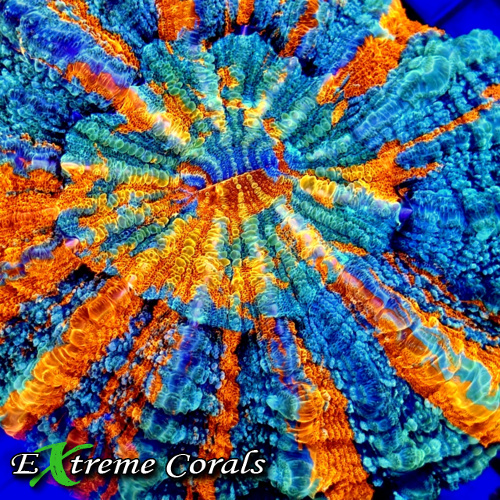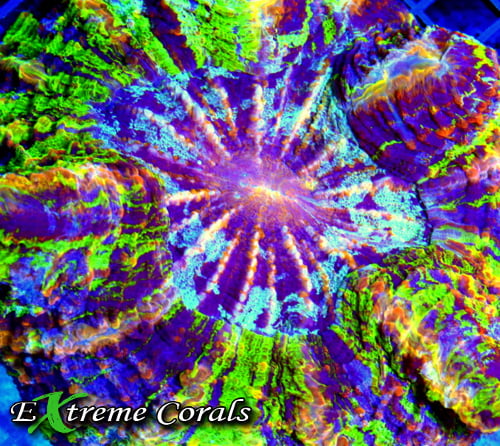Extreme Corals News and Updates
Guide to Acanthophyllia Care in Reef Aquariums
Master acanthophyllia care in reef aquariums with our comprehensive guide 'Guide to Acanthophyllia Care in Reef Aquariums'.
Expert advice on Acanthophyllia corals in your reef tank, from lighting and feeding to troubleshooting, ensuring a vibrant and thriving aquatic habitat.
by scott Shiles • April 01, 2024
What is Acanthophyllia?

Acanthophyllia is a type of large polyp stony (LPS) coral that is found in tropical waters. These corals have fleshy polyps with tentacles that extend to catch food. Acanthophyllia corals are known for their vibrant colors and unique patterns, making them a popular choice among reef aquarium enthusiasts. In aquariums, they require stable water parameters and moderate to high lighting. These corals are not aggressive towards other corals, making them suitable for a mixed reef tank.
Why choose Acanthophyllia for your reef aquarium?
Acanthophyllia is a great addition to your reef tank because they have vibrant colors and unique shapes, adding beauty to your aquarium. They are known for their hardiness, making them easier to care for compared to some other coral species. Acanthophyllia also have a moderate growth rate, not spreading too quickly and overcrowding your tank. Additionally, they can thrive under a variety of lighting and water flow conditions, making them versatile for different setups.
Care requirements for Acanthophyllia
Acanthophyllia corals require moderate to high lighting and stable water parameters to thrive in a reef aquarium. Keep the water temperature between 75°F and 80°F and maintain a stable pH level between 8.1 and 8.4. These corals do well in established aquariums and benefit from regular feedings of small meaty foods like shrimp or fish. It is essential to place them in a low to medium water flow area to prevent tissue damage. Additionally, ensure to monitor for any signs of stress or disease, as early detection can help maintain the health of your Acanthophyllia coral.
Importance of water quality
Water quality is crucial for the health of your Acanthophyllia coral in your aquarium. Poor water quality can lead to stress, disease, and even death for your coral. To maintain good water quality, you need to regularly test the water parameters such as pH, temperature, ammonia, nitrite, and nitrate levels. Ensure proper filtration and perform regular water changes to keep the water clean and stable. High levels of nutrients, pollutants, or fluctuations can harm your coral. Remember, maintaining excellent water quality is essential for the well-being of your Acanthophyllia coral.
Lighting needs for Acanthophyllia
Acanthophyllia corals prefer moderate to high lighting levels in reef aquariums. Place them in a spot where they can receive indirect light to partially direct light for optimal health. Metal halide, LED, or T5 lighting are recommended for Acanthophyllia corals to thrive. Be cautious of placing them too close to intense light sources as this can cause stress and harm the coral. Maintaining stable lighting conditions is crucial for the well-being of your Acanthophyllia coral.
Proper placement in the reef tank
Acanthophyllia should be placed on stable surfaces in the tank, away from strong water flow to prevent damage to its delicate tentacles. Ensure proper lighting is provided, as these corals need moderate to high light levels for optimal health. Keep a safe distance between Acanthophyllia and other corals to prevent stinging and maintain good water quality with regular testing and maintenance routines.
Feeding tips for Acanthophyllia
Acanthophyllia corals are known to thrive when provided with a varied diet. Regularly feeding them a mix of small meaty foods such as brine shrimp, mysis shrimp, and chopped seafood will keep them healthy and vibrant. Avoid overfeeding to prevent water quality issues. Target feeding with a turkey baster or feeding stick can help ensure the coral directly receives the food. Experiment with different foods to find what your Acanthophyllia prefers, as individual corals may have different preferences.
Common issues and troubleshooting
Sometimes, you may face common issues when caring for Acanthophyllia in your reef aquarium. Here are a few troubleshooting tips to help you out:
Algae Growth: Keep your aquarium water quality in check by monitoring and maintaining proper lighting levels, nutrient levels, and water flow.
Bleaching: Ensure your Acanthophyllia is getting adequate light and proper water parameters. If it's turning pale, adjust the lighting intensity and water conditions accordingly.
Aggression: If you notice your Acanthophyllia showing signs of stress or being targeted by other tank inhabitants, consider relocating it to a calmer area in the aquarium.
Disease: Regularly inspect your Acanthophyllia for any signs of disease, such as tissue recession or pests. Quarantine it if needed and treat with appropriate medications under the guidance of a marine biologist or reef aquarium specialist.
Reproduction and growth of Acanthophyllia
Acanthophyllia can reproduce by dividing itself into two separate individuals, a process known as "fission." This coral can also reproduce through asexual reproduction, where it produces identical offspring. When it comes to growth, Acanthophyllia thrives in well-maintained reef environments with stable water conditions. Adequate lighting and proper water flow are crucial for its growth.
Here are a few final tips to keep your Acanthophyllia coral thriving in your reef aquarium:
Ensure your tank's water parameters are consistently in check.
Regularly monitor the lighting and water flow in your aquarium.
Maintain stable and appropriate temperatures for your coral.
Feed your Acanthophyllia coral with small food particles like shrimp or fish once or twice a week.
Lastly, enjoy the beauty and uniqueness of your Acanthophyllia coral as it grows and adds vibrancy to your reef tank!

